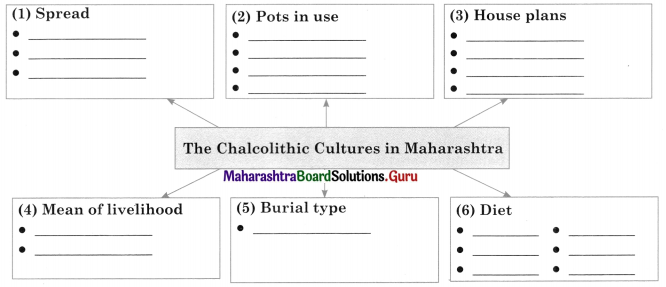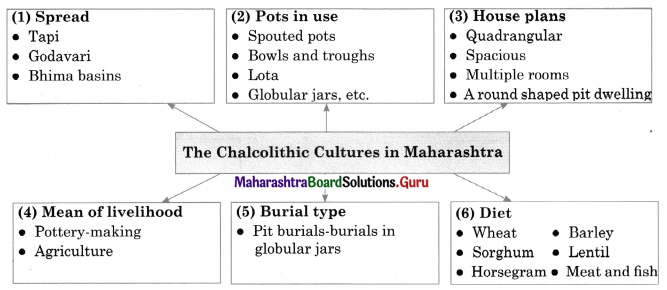Balbharti Maharashtra State Board Class 11 History Important Questions Chapter 3 Chalcolithic Villages in India Important Questions and Answers.
Maharashtra State Board 11th History Important Questions Chapter 3 Chalcolithic Villages in India
1A. Choose the correct alternative and write the complete sentences.
Question 1.
___________ culture at Balathal is dated to 4000 B.C.E.
(a) Ahar
(b) Jorwe
(c) Ganeshwar-Jodhpura
(d) Malwa
Answer:
(a) Ahar
Question 2.
Ahar culture is also known as ___________ culture.
(a) Jorwe
(b) Kayatha
(c) Banas
(d) Savalda
Answer:
(c) Banas
![]()
Question 3.
___________ is a site situated on the bank of the river known as Chhoti Kali Sindh.
(a) Savalda
(b) Navadatoli
(c) Malwa
(d) Kayatha
Answer:
(d) Kayatha
Question 4.
___________ was known as ‘Rangpur’.
(a) Maharashtra
(b) Gujarat
(c) Madhya Pradesh
(d) Rajasthan
Answer:
(b) Gujarat
Question 5.
Savalda is in ___________ district.
(a) Satara
(b) Ratnagiri
(c) Dhule
(d) Pune
Answer:
(c) Dhule
Question 6.
The culture in south Gujarat is known as ___________ culture.
(a) Pravhas
(b) Nevase
(c) Malwa
(d) Rangpur
Answer:
(a) Pravhas
![]()
Question 7.
The age when huge stone slabs were used is known as ___________ age.
(a) Palaeolithic
(b) Mesolithic
(c) Neolithic
(d) Megalithic
Answer:
(d) Megalithic
Question 8.
The archaeological evidence shows that ___________ was a centre of mass production of pottery.
(a) Gilund
(b) Khethri
(c) Balathal
(d) Baras
Answer:
(c) Balathal
1B. Find the incorrect pair from set ‘B’ and write the correct ones.
Question 1.
| Set ‘A’ | Set ‘B’ |
| (a) Malwa Culture | 1600-1400 B.C.E. |
| (b) Megalithic circles in India | 1500-500 B.C.E |
| (c) Early Jorwe Culture | 1400-1000 B.C.E. |
| (d) Late Jorwe Culture | 1000-800 B.C.E. |
Answer:
(d) Late Jorwe Culture – 1000-700 B.C.E.
Question 2.
| Set ‘A’ | Set ‘B’ |
| (a) Early Harappan phase | 3950-2600 B.C.E. |
| (b) Mature (urban) phase | 2500-1800 B.C.E. |
| (c) Savalda culture | 2000-1800 B.C.E. |
| (d) Post-Harappan phase | 1900-900 B.C.E. |
Answer:
(b) Mature (urban) phase – 2600-1900 B.C.E.
![]()
1C. Find the odd one out.
Question 1.
Ahar, Kayatha, Malwa, Mohenjodaro.
Answer:
Mohenjodaro
Question 2.
Early Harappan phase, Mature (Urban) phase, Pre Harappan Phase, Post-Harappan phase.
Answer:
Pre Harappan Phase
Question 3.
Malwa Culture, Early Jorwe Culture, Late Jorwe Culture, Post Late Jorwe Culture.
Answer:
Post-Late Jorwe Culture
Question 4.
Odisha, Todas, Kurumbas, Nagas.
Answer:
Nagas
Question 5.
Takalghat, Mahuzari, Khasis, Khapa.
Answer:
Khasis
Question 6.
Godavari, Inamgaon, Tapi, Bhima.
Answer:
Inamgaon
2A. Write the names of historical places, persons, and events.
Question 1.
A tributary of the river Banas
Answer:
Ahar
![]()
Question 2.
The culture found at Khetri
Answer:
Ganeshwar-Jodhpura
Question 3.
Pottery found in river beds
Answer:
Ochre coloured pottery
Question 4.
An important site of Malwa culture on the banks of Narmada
Answer:
Navadatoli
Question 5.
Tribes in Odisha
Answer:
Bodos
Question 6.
Furnace discovered near Nagpur
Answer:
Naikund
2B. Choose the correct reason and complete the sentence.
Question 1.
Ochre Coloured Pottery (OCP) and copper hoards are supposed to belong ___________
(a) one and the same culture
(b) one and the another culture
(c) similar culture
(d) different culture
Answer:
(a) one and the same culture
![]()
Question 2.
People of the Mature Harappan and the Late Harappan culture had the knowledge of ___________
(a) designs include motifs like sun, moon, fish, deer, and peacock
(b) wheel-made pottery
(c) the technology of making copper objects
(d) excavations of copper artifacts
Answer:
(b) wheel-made pottery
Question 3.
Kayatha culture was contemporary to the ___________
(a) Dholavira region
(b) Mohenjodaro
(c) Banas culture
(d) Harappan Civilisation
Answer:
(d) Harappan Civilisation
Question 4.
Ahar culture at Balathal is dated to ___________
(a) 400 B.C.E
(b) 40 B.C.E
(c) 4000 B.C.E
(d) 40000 B.C.E
Answer:
(c) 4000 B.C.E
2C. Write the correct chronological order.
Question 1.
(a) Malwa culture – 1800 B.C.
(b) Early Jorwe culture – 1400 B.C.
(c) Ahar culture – 4000 B.C.E.
(d) Savalda culture – 2000 B.C.E.
Answer:
(a) Ahar culture – 4000 B.C.E.
(b) Savalda culture – 2000 B.C.E.
(c) Malwa culture – 1800 B.C.E.
(d) Early Jorwe culture – 1400 B.C.E.
![]()
Question 2.
(a) Late Jorwe Culture – 1000-700 B.C.E.
(b) Kutch – Saurashtra was abandoned by 1900 B.C.E.
(c) Early Jorwe Culture – 1400-1000 B.C.E.
(d) Malwa Culture – 1600-1400 B.C.E.
Answer:
(a) Kutch – Saurashtra were abandoned by 1900 B.C.E.
(b) Malwa Culture – 1600-1400 BCE
(c) Early Jorwe Culture – 1400-1000 B.C.E.
(d) Late Jorwe Culture – 1000-700 B.C.E.
Question 3.
(a) Mature (urban) phase – 2600-1900 B.C.E.
(b) ‘Ahar’ culture at Balathal – 4000 B.C.E.
(c) Post-Harappan phase – 1900-900 B.C.E.
(d) Early Harappan phase – 3950-2600 B.C.E.
Answer:
(a) ‘Ahar’ culture at Balathal – 4000 B.C.E.
(b) Early Harappan phase – 3950-2600 B.C.E.
(c) Mature (urban) phase – 2600-1900 B.C.E.
(d) Post-Harappan phase – 1900-900 B.C.E.
3. Complete the concept maps.
Question 1.

Answer:

Question 2.

Answer:

Question 3.

Answer:

![]()
Question 4.

Answer:

4. Write short notes.
Question 1.
Ochre coloured pottery
Answer:
- Initially, the Ochre Coloured Pottery (OCP) was mostly found in river beds.
- Generally, the potsherds of OCP are found in worn-out, rounded, and brittle conditions as they remained in flowing water for a long time.
- A number of sites of the OCP are found in Punjab, Haryana, Rajasthan, and the western region of Uttar Pradesh.
- The OCP culture in Rajasthan is dated about 3000 B.C.E.
Question 2.
Jorwe Pottery
Answer:
- Jorwe pots are well baked giving a metallic sound and designs on these pots are painted in brown.
- They are red in colour with designs painted in black.
- Jorwe pottery includes shapes like spouted pots, carinated bowls, and troughs (carination is the central ridge on the pot), lota, globular jars, etc.
- The Late Jorwe people made pots of the same shapes, but without any decoration.
5. Explain the statements with reasons.
Question 1.
There were two chalcolithic cultures in Gujarat, in the post-Harappan period.
Answer:
- In the post-Harappan period, there were two chalcolithic cultures in Gujarat.
- The culture in south Gujarat was known as ‘Prabhas’ culture and the one in northeastern Gujarat was known as ‘Rangpur’ culture.
- The pottery of these chalcolithic cultures was akin to Late Harappan pottery with regards to the colour, shapes, and designs.
- These cultures existed till 1800-1200 B.C.E.
Question 2.
Savalda people and The Harappans in Saurashtra had trade relations.
Answer:
- There was a cultural contact between the Savalda people and the Harappans in Saurashtra.
- Its evidence has been found at the site of Kaothe in Dhule district.
- The artifacts made of chank shells found at Kaothe confirm that the Savalda people and The Harappans in Saurashtra had trade relations.
![]()
6. State your opinion.
Question 1.
Kayatha culture was contemporary to the Harappan civilisation.
Answer:
- The people of Kayatha culture subsisted on agriculture and animal husbandry.
- They mainly used handmade pots and microliths.
- Artifacts like copper axes and bangles, necklaces made of beads of steatite were found in the Kayatha houses.
- People of Kayatha culture and Harappan culture seem to have been in contact much before the rise of the Harappan cities.
Question 2.
Ochre Coloured Pottery (OCP) and copper hoards are supposed to belong to one and the same culture.
Answer:
- The Copper Hoards found in India come from various regions, such as Uttar Pradesh, Bihar, Bengal, Odisha, and Madhya Pradesh.
- The copper objects found in these hoards indicate that the artisans who fashioned them were very highly skilled.
- The archaeological sites of OCP and the find-spots of the copper hoards often seem to be situated in the same vicinity, not very distant from each other.
- Hence, OCP and copper hoards are supposed to belong to one and the same culture.
7. Answers the following questions in detail.
Question 1.
Write a note on ‘Jorwe’ pottery.
Answer:
- Jorwe pots are well baked giving a metallic sound. They are red in colour with designs painted in black.
- Jorwe pottery includes shapes like spouted pots, carinated bowls, and troughs, lota, globular jars, etc.
- The late Jorwe people made pots of the same shapes but without any decoration.
- Potters kilns were found in both Malwa and Early Jorwe periods.
- They were round in shape. The kiln of the early Jowre period was larger and of greater capacity.
- In the late Jorwe period potters did not have a specially built kiln. They baked their pots directly on the ground.
- Inamgaon was the centre of pottery production which supplied pottery to the surrounding villages.
![]()
Question 2.
Discuss the Megalithic period in India.
Answer:
- A nomadic people around 700 B.C.E. erected stone circles by using huge slabs of rock.
- The space within these circles was used to bury dead people.
- These circles are known as Megaliths. The period of these Megaliths is known as the ‘Megalithic Age’.
- They were used for various purposes, but mainly they contain the remains of the dead.
- They were the memorials of the dead. Such megalithic circles have been found in many parts of the world.
- A few tribes in India practice it even today. For instance; the Bodos in Odisha, Todas, and Kurumbas in South India.
- Nagas and Khasis in Northeast India. Most of these circles in India are dated to 1500-500 B.C.E.
- Perhaps these people were from South India. The Megalithic circles in Maharashtra belong to the Iron Age. They are dated to 1000-400 B.C.E.
- In Maharashtra, Megalithic burials have been found in the Vidarbha region especially in the districts of Nagpur, Chandrapur, and Bhandara.
- Megalithic people used horses for transport and travel. They were instrumental in introducing the ‘Iron Age’ in ancient India.
8. Answer the following questions with the help of given points.
Question 1.
Write a note with the help of the following points:
(a) ‘Ahar’ or ‘Banas’ Culture
(b) Ganeshwar – Jodhpur Culture
(c) Kayatha Culture
(d) Malwa Culture
Answer:
(a) ‘Ahar’ or ‘Banas’ Culture: The chalcolithic cultures in India generally belong to the post- Harappan period. However, the ‘Ahar’ or ‘Banas’ culture in the Mewad region of Rajasthan was contemporary to the Harappan civilisation. Balathal and Gilund near Udaipur are the important sites of Ahar culture. ‘Ahar’ culture at Balathal is dated to 4000 B.C.E and was first discovered at Ahar near Udaipur, so it was named as ‘Ahar’ culture.
(b) Ganeshwar-Jodhpura Culture: Many sites of the culture known as ‘Ganeshwar-Jodhpura’ culture have been found in the vicinity of the copper mines at Khetri. The settlements there are earlier than the Harappan civilisation. During the excavations at Ganeshwar copper artifacts like arrowheads, spearheads, harpoons, bangles, chisels, and also pottery was found. The people of Ganeshwar-Jodhpura culture supplied copper objects to the Harappans.
(c) Kayatha Culture: Kayatha is a site situated on the banks of the river known as Chhoti Kali Sindh, at a distance of 25 kilometers from Ujjain in Madhya Pradesh. Kayatha culture was contemporary to the Harappan civilisation. The people of Kayatha culture subsisted on agriculture and animal husbandry.
![]()
(d) Malwa Culture: The name ‘Malwa’ obviously tells us that this culture originated and spread first in the Malwa region. It existed in Madhya Pradesh during 1800-1200 B.C.E. ‘Navadatoli’ situated on the river Narmada, on the opposite bank of Maheshwar, is an important site of Malwa culture. The other important sites are Eran (District Sagar) and Nagda (District Ujjain). They were surrounded by protective walls.